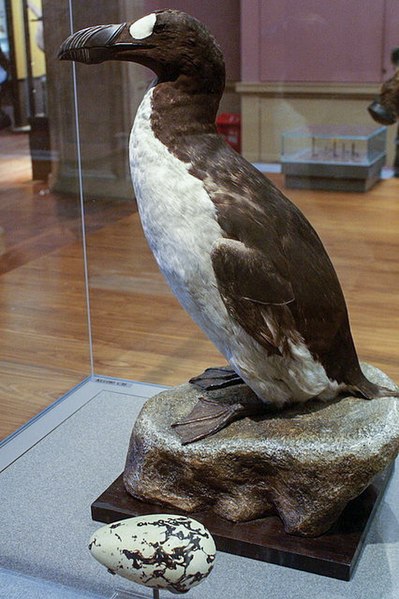Plik:Great Auk (Pinguinis impennis) specimen, Kelvingrove, Glasgow - geograph.org.uk - 1108249.jpg

Rozmiar podglądu – 399 × 599 pikseli. Inne rozdzielczości: 160 × 240 pikseli | 426 × 640 pikseli.
Rozmiar pierwotny (426 × 640 pikseli, rozmiar pliku: 271 KB, typ MIME: image/jpeg)
Historia pliku
Kliknij na datę/czas, aby zobaczyć, jak plik wyglądał w tym czasie.
| Data i czas | Miniatura | Wymiary | Użytkownik | Opis | |
|---|---|---|---|---|---|
| aktualny | 11:26, 11 sie 2017 |  | 426 × 640 (271 KB) | Archaeodontosaurus | Corrections |
| 19:46, 24 lut 2011 |  | 426 × 640 (78 KB) | GeographBot | == {{int:filedesc}} == {{Information |description={{en|1=Great Auk (Pinguinis impennis) specimen, Kelvingrove, Glasgow A lost part of the biogeography of Britain, and the only flightless bird that has bred in Europe in historical times. The last Great Auk |
Lokalne wykorzystanie pliku
Poniższa strona korzysta z tego pliku:
Globalne wykorzystanie pliku
Ten plik jest wykorzystywany także w innych projektach wiki:
- Wykorzystanie na ar.wikipedia.org
- Wykorzystanie na arz.wikipedia.org
- Wykorzystanie na ast.wikipedia.org
- Wykorzystanie na as.wikipedia.org
- Wykorzystanie na az.wikipedia.org
- Wykorzystanie na bg.wikipedia.org
- Wykorzystanie na bn.wikibooks.org
- Wykorzystanie na ca.wikipedia.org
- Wykorzystanie na da.wikipedia.org
- Wykorzystanie na de.wikipedia.org
- Wykorzystanie na en.wikipedia.org
- Wykorzystanie na en.wikibooks.org
- Wykorzystanie na en.wiktionary.org
- Wykorzystanie na es.wikipedia.org
- Wykorzystanie na et.wikipedia.org
- Wykorzystanie na eu.wikipedia.org
- Wykorzystanie na fa.wikipedia.org
- Wykorzystanie na fi.wiktionary.org
- Wykorzystanie na fo.wikipedia.org
- Wykorzystanie na fr.wikipedia.org
- Wykorzystanie na fy.wikipedia.org
- Wykorzystanie na ga.wikipedia.org
- Wykorzystanie na gd.wikipedia.org
- Wykorzystanie na gl.wikipedia.org
- Wykorzystanie na he.wikipedia.org
- Wykorzystanie na ia.wikipedia.org
- Wykorzystanie na it.wikipedia.org
- Wykorzystanie na ja.wiktionary.org
- Wykorzystanie na jv.wikipedia.org
- Wykorzystanie na la.wikipedia.org
- Wykorzystanie na lv.wikipedia.org
- Wykorzystanie na ml.wikipedia.org
- Wykorzystanie na mrj.wikipedia.org
- Wykorzystanie na no.wikipedia.org
Pokaż listę globalnego wykorzystania tego pliku.
